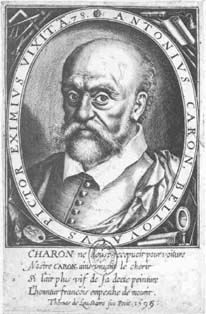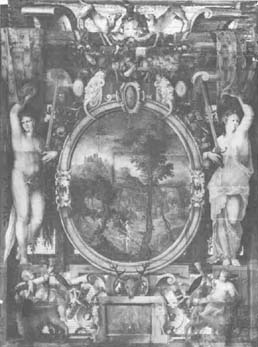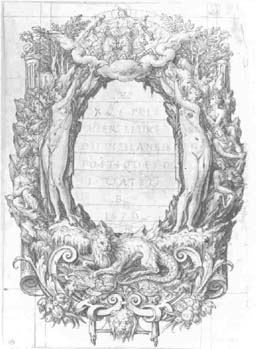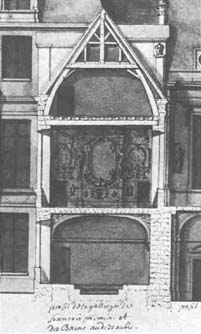
Bulletin 26, 1975
Home
Français
Introduction
History
Annual Index
Author &
Subject
Credits
Contact





The Monumental Style of Fontainebleau
and
its Consequences: Antoine Caron and
"The Submission of Milan"
by W. McAllister Johnson
Résumé en français
Pages 1 | 2 |
3 | 4
In the normal course of events, study of a newly-discovered painting is apt more to
concern its attribution than its method of pictorial representation, however
unusual this may be. When such a painting is the first of its kind
known and acquired by a national collection, an unusual occasion is afforded
scholar and public to consider its subject matter and "visual syntax"
or collocation of motifs. All this is the more refreshing when the received
title distorts somewhat the subject actually given, and when the manner
of presentation has several different levels of reality incidentally alluding
to a series of historical developments which find their illustration
in artistic monuments.
Thus it is that the Surrender of Milan (fig. 9), attributed
to Antoine Caron and first exhibited upon the occasion of the School
of Fontainebleau exhibition at Ottawa in 1973, (1) is in reality a Submission
of Milan. Despite its relatively small format, the panel is a virtual
anthology of the diverse events leading up to the Submission whose formal organization can be related to prior developments in monumental
decorative schemes of royal origin in France during the 1530s and 1540s
- and thence to their Roman antecedents earlier in the century.
It was said at the time, it has been repeated ever after, that the art of Fontainebleau
is the art of the cartouche - without, however, retaining the full
weight of the term as it appears in the mind's eye rather than to the eye
itself.
As a "regularly irregular" form for which sixteenth...century
France and Italy had a special predilection, (2) the oval is the only geometrical
figure to permit - even to invite - inherent ambiguities of centrality and
axiality without exception to modifications occasioned in its use. (3) Its
ambivalent quality is at once intellectual and visual in nature: the spectator
must experience not only the relation of the surround to what it enframes
(the "first level" of identification of motif) but simultaneously the possible
levels of signification of apparent motifs in or towards some guiding scheme.
At least three distinct treatments of the individual oval surround
may be determined, most notably that in which the figures are densely compacted
around the cartouche, manifestly directing their attention and gestures
- and thus, those of the viewer - to some central motif (fig. 2). An alternative
conception relies for emphasis upon an exceptional variety of figures
and materials and represents a derivation in illusionistic painting of
the Francis I Gallery at Fontainebleau (fig. 3). (4) Finally, there are those
instances in which the pictorial surround is an historiated one in the
strict sense, which is to say that all figures present correspond
in an emblematic way to an idea while the cartouche field is of
little or no importance (fig. 4). In as much as the oval field is almost
invariably integrated within some other, more regular geometrical shape(s)
(fig. 5), a certain tension may exist between the implications of the original
motif and its realisation in three dimensions in some larger context (5)
- not to say its free adaptation afterwards, whether with or without knowledge
of the prototype. (6)
The "historiated" or, if one will, "emblemated" picture frame so peculiar
to sixteenth-century art in general can only suppose interchange or correspondence
at various levels once the written texts have been translated into
visual elements which put forth in some effective way a concept or illustrate
an event. Some sense of the evolution of the monumental style of Fontainebleau
and its consequences in decoration, illustration, and the minor arts may
be had by a wider public in a study of selected examples.
The explosion in number and kind of imagery had characteristic results
during the later Renaissance. Not the least of these is the appearance
and wide diffusion of loosely agglomerated or serial publications commonly
known as suites. At a usual level of application, these concern
some category of interest in a real or abstract sense - the Senses, the
Seasons, the Occupations of the Months, the Virtues and Vices - all of
which may be circumscribed in number. The more
complex and innovative series possess a highly developed pictorial
sense in respect of subjects of more esoteric nature which could be indefinitely
extended, assuming the will of the artist or patron to be sufficiently
engaged. Then as now, it is likely that suites were thought of in graphic
form, as these could be widely circulated and influential, regardless of
origin, in the international commerce. By extension, the suite necessarily
included programmed or integrated ensembles of a higher sort that were
unique in number: chambers, palaces, landscape gardening and urbanism
on the one hand, and commemorative projects (particularly those of dynastic
intent) such as drawings and tapestries on the other. Such a series is
the Histoire françoyse de nostre temps, a retrospective of
the considerable events of the French monarchy begun in the early years
of the reign of Charles IX (1561- 1574). (7) Its drawings are ascribed to
Antoine Caron of Beauvais (c. 1521-1599) -"distinguished or uncommon
painter" according to the posthumously engraved portrait by his son-in-law
Thomas de Leu (fig. 1). (8)
A text to this may have existed in manuscript, but it is typical
of the period that the Histoire françoyse is perfectly comprehensible
in its synoptical form as a drawings suite and has always been referred
to as such. A companion suite also ascribed to Caron, the Histoire de
la Reine Arthémise, forms the counterpoint to the purely historical Histoire françoyse.
Presenting in allegorical guise events
from the widowhood of Catherine de' Medici and the early reign of Charles IX, it
is known to have been "reduced" to pure pictorial form from a still
extant manuscript. Both suites seem to have been "extended" in aleatory
fashion as the need was felt, and the sometime discovery of new drawings
reveals that our knowledge may as yet be incomplete.
As a general rule, the drawings maintain the narrative thread
by virtue of sonnets inscribed on the back of one sheet which explicate
the scene to follow. (Not all drawings possess sonnets; it is assumed that
the verse is posterior to the image, when present.) In such case, the comparison
of the abbreviated poetic history and the image should prove consonant
in essentials.
Next Page | the
chronological sequence
1 |
2 |
3 | 4
Annual Index | Author & Subject | Credits | Contact
This digital collection
was produced under contract to Canada's Digital Collections program,
Industry Canada.
"Digital
Collections Program, Copyright
© National Gallery of
Canada 2001"